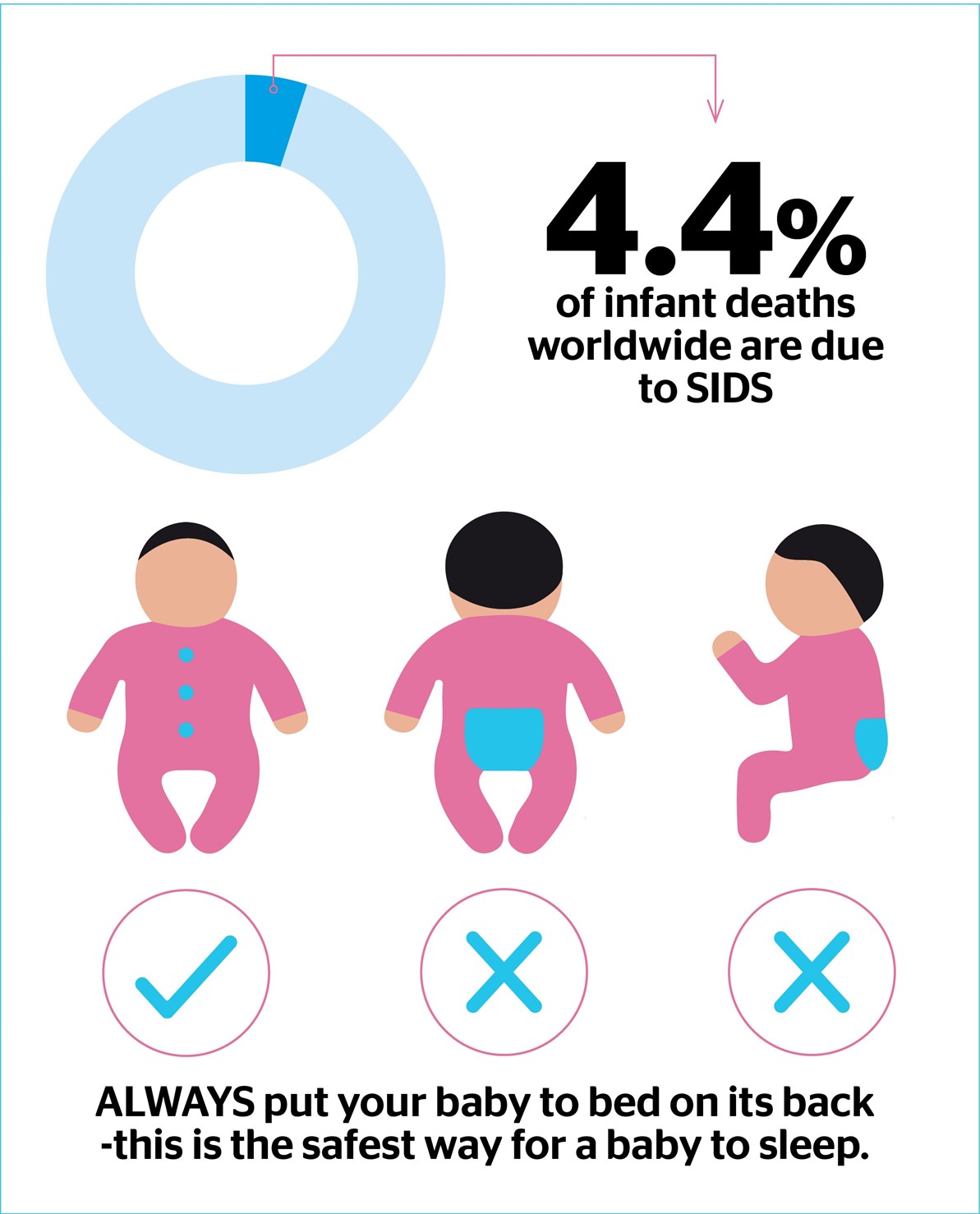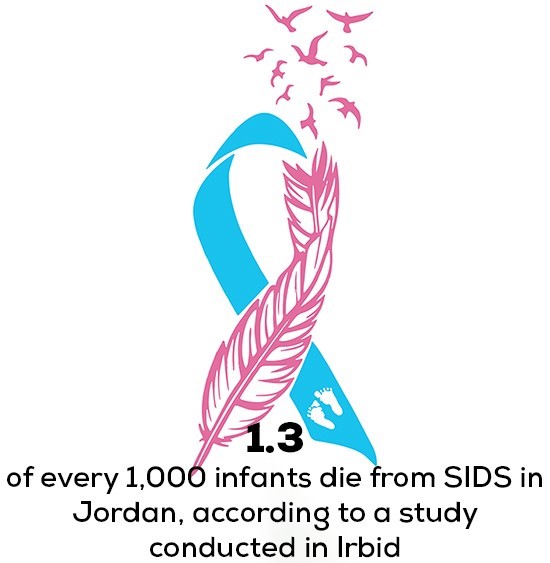Having a
child can be stressful, especially for first-time parents. Every parent wants
their child to be healthy and happy. Unfortunately, infancy, typically defined
as the first 365 days after birth, can be the scariest time for parents, as
children at this age are at risk of a condition known as
sudden infant death syndrome (SIDS).
اضافة اعلان
According to
statistics published in 2010, SIDS is the third leading cause of infant
mortality. It is estimated that roughly 8.6 percent of infant deaths in the
US are caused by SIDS. To date, the most useful tool we have to help combat this
is education and spreading awareness, in hopes of reducing incidences.
Unexpected,
unexplained
SIDS is the sudden, unexpected, and often unexplained death of a seemingly
healthy infant. It is the most common cause of death for infants between the
ages of one month and one year old, but most frequently occurs between the ages
of two and four months. It also occurs most often during sleep, and is
sometimes referred to as crib death as a result.
The cause of SIDS
is still unknown, but many theories exist. The leading theory is that an infant
who dies as a result of SIDS lacks the necessary neurotransmitters in
sufficient levels to wake up.
Neurotransmitters are small chemicals that help
send messages, and the one in question is acetylcholine (Ach). Ach belongs to a
system known as the cholinergic system, which plays a role in many life
sustaining functions such as heart rhythm and breathing. It has also been found
to play a significant role in waking. Any deficits in Ach and the cholinergic
system as a whole could result in an infant not being able to wake up.
This theory has
gained further support after a study published this year found that infants who
died as a result of SIDS had lower levels of butyrylcholinesterase (
BChE)
compared to living infants and infants who died of other causes. BChE is an
enzyme that helps regulate Ach, and lower levels of this enzyme may suggest a
cholinergic deficit. However, it should be noted that low levels of BChE only
serve as an indicator, not a cause.
The triple-risk model
Additionally, it is believed that SIDS is not caused by deficits or
abnormalities alone. Instead, it has been proposed that SIDS is the result of
three risk factors that can lead to SIDS only when all of them are present.
This is referred to as the triple-risk model. The first risk factor is infant
vulnerability. This factor covers underlying conditions such as cholinergic
deficits, and can also include potential genetic disorders.

The second risk
factor is that the infant is within the critical developmental period, which is
generally considered to be the first six months of life, but can last up until
the first year. The final factor is the presence of external environmental
stressors. These environmental stressors are not considered to be a definitive
cause, but instead greatly reduce the chance of a vulnerable infant overcoming
other risks.
Environmental
stressors
Many household and caregiving practices have been used for centuries, but
that does not mean that they are all healthy or safe. As the understanding of
SIDS has improved, so too has the identification of potentially harmful
practices. These practices are considered environmental stressors and may
negatively contribute to an infant’s odds of survival.
The most
significant risk factors for SIDS are sleep practices. Before the age of one
year, it is important to ensure your baby sleeps fully on their back and not on
their side or stomach. Similarly, it has been found that having the infant
sleep in the same room as you reduces the risk of SIDS. However, the infant
should be in the crib by themselves, since sharing a bed with a parent,
sibling, or pet can increase the level of risk.
Additionally,
swaddling an infant can help reduce the risk of SIDS, but it must be done
properly, or the risk will increase. Infants should not be wrapped in multiple
layers, even in the winter, and their heads should not be wrapped or covered. This
is because improper swaddling can cause overheating, which can raise the risk
of sudden, unexpected death. Lastly, the crib should be safe and have a firm
mattress, and toys, pillows, blankets, and sleep positioners/bumpers should be
removed.

Furthermore,
infants born premature (at less than 37 weeks) or those with low birthweight
have up to a four times greater risk. Another factor that can increase the
danger of SIDS occurring is a recent respiratory infection, particularly in
babies that are older than three months. Lastly, smoking can have a serious
impact on the risk of SIDS. Mothers who smoke during pregnancy place their
child at a three times greater risk of SIDS. Similarly, smoking near an infant
(also referred to as second-hand smoke) doubles the risk of SIDS.
SIDS in Jordan
The incidence of SIDS in Jordan is minimal, and this holds true for the
entire Middle East. However, depending on the source, the
Middle East may have
a higher incidence compared to Western nations. According to the Institute for
Health Metrics and Evaluation’s Global Burden of Disease 2017 data, sudden
infant death accounts for 4.4 percent of infant deaths. However, a 2005 study
conducted in Irbid found that SIDS occurs in 1.3 infants per every 1,000.
Meanwhile, the US reported in the same year that SIDS occurred in an average
0.54 per every 1,000 infants, meaning that Jordan has an incidence rate nearly
2.5 times greater. Another study found Jordan to have a nearly 13 times greater
rate of SIDS than the Netherlands.
It has been
suggested that the cause for the higher incidence rate is not due to inherent
genetic differences between the Middle East and Western nations, but instead,
cultural practices. A 2016 study conducted in Jordan looked at several
household practices that mothers use to care for their infants. The study found
that the majority of Jordan’s mothers do follow important, proper methods to
reduce the risk of SIDS. For example, it was found that 92 percent of mothers
do not lay their infants on their stomachs to sleep, and 90 percent keep their
infants in their room to be supervised during the night.
However, it was also found that 88 percent of mothers place
their infants on their sides, and 50 percent do this most of the time.
Additionally, 81 percent of mothers reported using multiple layers of quilts
during the winter to cover their babies, and 84 percent indicated that they
cover their infants’ heads. Lastly, 73 percent reported using kerosene, wood,
or gas heaters in a closed room during the winter, while only 10 percent
regularly ventilate the room (about every two hours). It was concluded that
Jordanians frequently participate in practices that place their infants at a
higher risk for SIDS.
Read more Health
Jordan News



